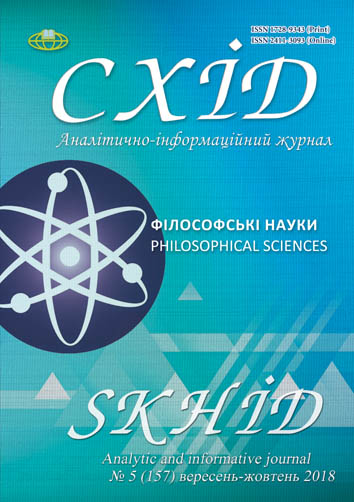Ancient psychotechnics as a means of compensation of lost existential experience
DOI:
https://doi.org/10.21847/1728-9343.2018.5(157).148997Keywords:
psychotechnics, existential experience, transpersonal experiences, altered state of consciousness, shamanism, mystery, Daoism, Hinduism, BuddhismAbstract
The present article deals with ancient psychotechnics and its role in restoring the access to existential experience that serves as a source of energy and basic vital intuition. The purpose is to determine the influence of psychotechnic traditions on compensation of deficiency of existential experience and unity of humans and the natural world in order to discover universal images and symbols which underlie all religious systems. Deep attention is paid to altered states of consciousness whose crucial importance reveals itself in the activation of subconscious mind and liberation from limitations imposed by the loss of connection with the Being in its simple and genuine forms. The author focuses on the description of common features that characterize religious systems regardless of cultural distinctions. It’s extremely significant to emphasize that those intuitions, considered as an inherent element of specific religion, are completely accessible to persons who belong to different cultural traditions. There are reasons to affirm that shamanism, Greek mysteries; Daoism, Hinduism and Buddhism have the same origin and the same mission - overcome alienation from the Being with the objective of achieving of personal salvation. Trance immersion deserves special mention because of the possibility of facilitating access to subconscious layers and transpersonal experiences as a means of reaching inner harmony. It is proved that the visions which arise in a trance state are nearly identical to hallucinations caused by psychotropic substances. Scientific innovation of the study consists in the attempt to demonstrate the correlation between ancient psychotechnic traditions and the urgent necessity to solve modern existential crisis.Downloads
References
Bourguignon, E. 2001. Altered states of consciousness [translat.]. Personality, culture, ethnos: psychological anthropology. Smysl Publishing, Moscow: 405-461 (rus).
Freidenberg, O. 1978. Myth and literature of antiquity. Nauka, Moscow, 605 p. (rus).
Grof, S. 2004. The transpersonal vision: the healing potential of non-ordinary states of consciousness. AST, Moscow, 239 p. (rus).
James, W. 1993. The varieties of religious experience [translat.]. Respublika, Moscow, 432 p. (rus).
LaBerge, S. 1991. Exploring the world of lucid dreaming. Ballantine Books, New York, 352 p.
McKenna, T. 1992. Food of the gods: the search for the original tree of knowledge. A radical history of plants, drugs and human evolution. Bantam, New York, 311 p.
Mindell, A. 1993. The shaman’s body: a new Shamanism for transforming health, relationships and community. HarperOne, San Francisco, 256 p.
Moss, R. 2010. The secret history of dreaming. New World Library, San Francisco, 352 p.
Rudoy, V. and Ostrovskaya, E. 1987. About the specificity of historical and philosophical approach to the study of classic religious and philosophical systems of India. Methodological problems of study of the history of Oriental philosophy. Nauka, Moscow: 74-93 (rus).
Tart, Ch. 1992. States of consciousness [translat.]. Magic crystal. Respublika, Moscow: 180-248 (rus).
Torchynov, E. 2007. World religions: experience of the transcendence. Transpersonal states. Oriental Studies, Saint Petersburg, 540 p. (rus).
Walsh, R. 1990. The spirit of shamanism. Jeremy P.Tarcher Publisher, Los Angeles, 285 p.
Weber, M. 1990. Selected works [translat.]. Progress, Moscow, 804 p. (rus).
Downloads
Published
How to Cite
Issue
Section
License
Copyright (c) 2018 Leonid Solonko

This work is licensed under a Creative Commons Attribution-NonCommercial-NoDerivatives 4.0 International License.
1. Authors bear responsibility for the accuracy of facts, quotations, numbers and names used.
2. Manuscripts are not sent back.
3. The publisher does not always agree with the authors' opinion.
4. The authors reserve the right to authorship of the work and pass the first publication right of this work to the journal under the terms of a Creative Commons Attribution-NonCommercial-NoDerivatives 4.0 International License. This license allows others to distribute (copy) the published work for non-commercial purposes, provided there is mandatory attribution to its authors and a link to the first publication in our journal.
5. The authors have the right to conclude separate supplement agreements that relate to non-exclusive work distribution in the form in which it has been published by the journal (for example, to upload the work to the online storage of the journal or publish it as part of a monograph), provided that the reference to the first publication of the work in this journal is included.

